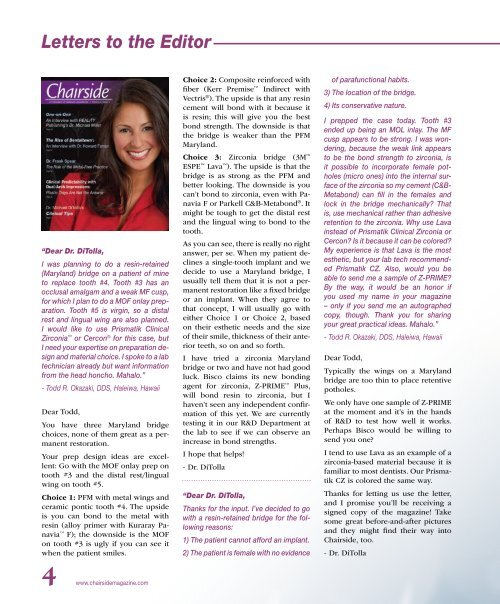PDF Version - Glidewell Dental Labs
PDF Version - Glidewell Dental Labs
PDF Version - Glidewell Dental Labs
You also want an ePaper? Increase the reach of your titles
YUMPU automatically turns print PDFs into web optimized ePapers that Google loves.
Letters to the Editor<br />
“Dear Dr. DiTolla,<br />
I was planning to do a resin-retained<br />
(Maryland) bridge on a patient of mine<br />
to replace tooth #4. Tooth #3 has an<br />
occlusal amalgam and a weak MF cusp,<br />
for which I plan to do a MOF onlay preparation.<br />
Tooth #5 is virgin, so a distal<br />
rest and lingual wing are also planned.<br />
I would like to use Prismatik Clinical<br />
Zirconia or Cercon ® for this case, but<br />
I need your expertise on preparation design<br />
and material choice. I spoke to a lab<br />
technician already but want information<br />
from the head honcho. Mahalo.”<br />
- Todd R. Okazaki, DDS, Haleiwa, Hawaii<br />
Dear Todd,<br />
You have three Maryland bridge<br />
choices, none of them great as a permanent<br />
restoration.<br />
Your prep design ideas are excellent:<br />
Go with the MOF onlay prep on<br />
tooth #3 and the distal rest/lingual<br />
wing on tooth #5.<br />
Choice 1: PFM with metal wings and<br />
ceramic pontic tooth #4. The upside<br />
is you can bond to the metal with<br />
resin (alloy primer with Kuraray Panavia<br />
F); the downside is the MOF<br />
on tooth #3 is ugly if you can see it<br />
when the patient smiles.<br />
4<br />
www.chairsidemagazine.com<br />
Choice 2: Composite reinforced with<br />
fiber (Kerr Premise Indirect with<br />
Vectris ® ). The upside is that any resin<br />
cement will bond with it because it<br />
is resin; this will give you the best<br />
bond strength. The downside is that<br />
the bridge is weaker than the PFM<br />
Maryland.<br />
Choice 3: Zirconia bridge (3M <br />
ESPE Lava ). The upside is that the<br />
bridge is as strong as the PFM and<br />
better looking. The downside is you<br />
can’t bond to zirconia, even with Panavia<br />
F or Parkell C&B-Metabond ® . It<br />
might be tough to get the distal rest<br />
and the lingual wing to bond to the<br />
tooth.<br />
As you can see, there is really no right<br />
answer, per se. When my patient declines<br />
a single-tooth implant and we<br />
decide to use a Maryland bridge, I<br />
usually tell them that it is not a permanent<br />
restoration like a fixed bridge<br />
or an implant. When they agree to<br />
that concept, I will usually go with<br />
either Choice 1 or Choice 2, based<br />
on their esthetic needs and the size<br />
of their smile, thickness of their anterior<br />
teeth, so on and so forth.<br />
I have tried a zirconia Maryland<br />
bridge or two and have not had good<br />
luck. Bisco claims its new bonding<br />
agent for zirconia, Z-PRIME Plus,<br />
will bond resin to zirconia, but I<br />
haven’t seen any independent confirmation<br />
of this yet. We are currently<br />
testing it in our R&D Department at<br />
the lab to see if we can observe an<br />
increase in bond strengths.<br />
I hope that helps!<br />
- Dr. DiTolla<br />
“Dear Dr. DiTolla,<br />
Thanks for the input. I’ve decided to go<br />
with a resin-retained bridge for the following<br />
reasons:<br />
1) The patient cannot afford an implant.<br />
2) The patient is female with no evidence<br />
of parafunctional habits.<br />
3) The location of the bridge.<br />
4) Its conservative nature.<br />
I prepped the case today. Tooth #3<br />
ended up being an MOL inlay. The MF<br />
cusp appears to be strong. I was wondering,<br />
because the weak link appears<br />
to be the bond strength to zirconia, is<br />
it possible to incorporate female potholes<br />
(micro ones) into the internal surface<br />
of the zirconia so my cement (C&B-<br />
Metabond) can fill in the females and<br />
lock in the bridge mechanically? That<br />
is, use mechanical rather than adhesive<br />
retention to the zirconia. Why use Lava<br />
instead of Prismatik Clinical Zirconia or<br />
Cercon? Is it because it can be colored?<br />
My experience is that Lava is the most<br />
esthetic, but your lab tech recommended<br />
Prismatik CZ. Also, would you be<br />
able to send me a sample of Z-PRIME?<br />
By the way, it would be an honor if<br />
you used my name in your magazine<br />
– only if you send me an autographed<br />
copy, though. Thank you for sharing<br />
your great practical ideas. Mahalo.”<br />
- Todd R. Okazaki, DDS, Haleiwa, Hawaii<br />
Dear Todd,<br />
Typically the wings on a Maryland<br />
bridge are too thin to place retentive<br />
potholes.<br />
We only have one sample of Z-PRIME<br />
at the moment and it’s in the hands<br />
of R&D to test how well it works.<br />
Perhaps Bisco would be willing to<br />
send you one?<br />
I tend to use Lava as an example of a<br />
zirconia-based material because it is<br />
familiar to most dentists. Our Prismatik<br />
CZ is colored the same way.<br />
Thanks for letting us use the letter,<br />
and I promise you’ll be receiving a<br />
signed copy of the magazine! Take<br />
some great before-and-after pictures<br />
and they might find their way into<br />
Chairside, too.<br />
- Dr. DiTolla

















